Daugherty Hall at the University of Delaware
A gathering place for all and where the University of Delaware’s Gay Student Union hosted its weekly coffeehouses.
1970s-Present,
17 W. Main Street, Newark, DE
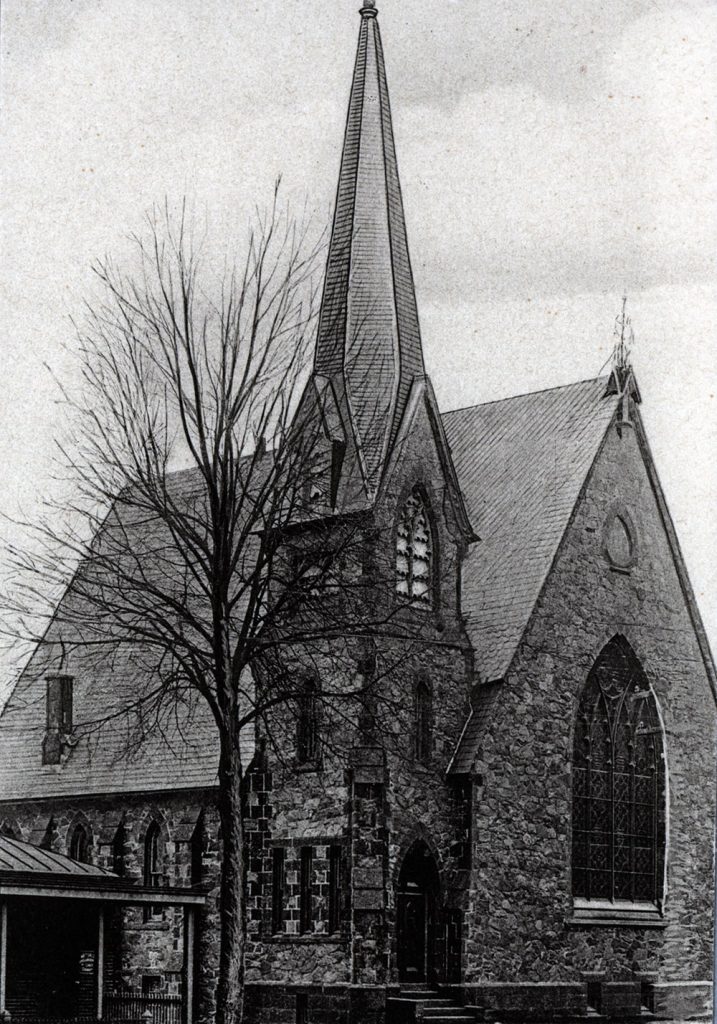
Starting in the 1970s, Daugherty Hall was the main gathering space for members of the University of Delaware’s Gay Student Union and Gay Community groups. It was known at the time for hosting Friday evening coffeehouses where queer students held discussion groups and enjoyed game nights, food, and entertainment. Today the building is used as a quiet study area.
Daugherty Hall, a church-turned-student-center at the end of Main Street in Newark, has served as a gathering place for gay students from the University of Delaware (UD) and surrounding community for decades. In 2017, UD’s first Lavender Graduation, a celebration facilitated through the Division of Student Life to recognize the unique achievements of LGBTQ+ seniors, was held there.
But it was the brief closure of Daugherty Hall at the University of Delaware during the mid-1970s that coincided with a controversial event on campus drastically impacting Delaware’s queer community at the time.
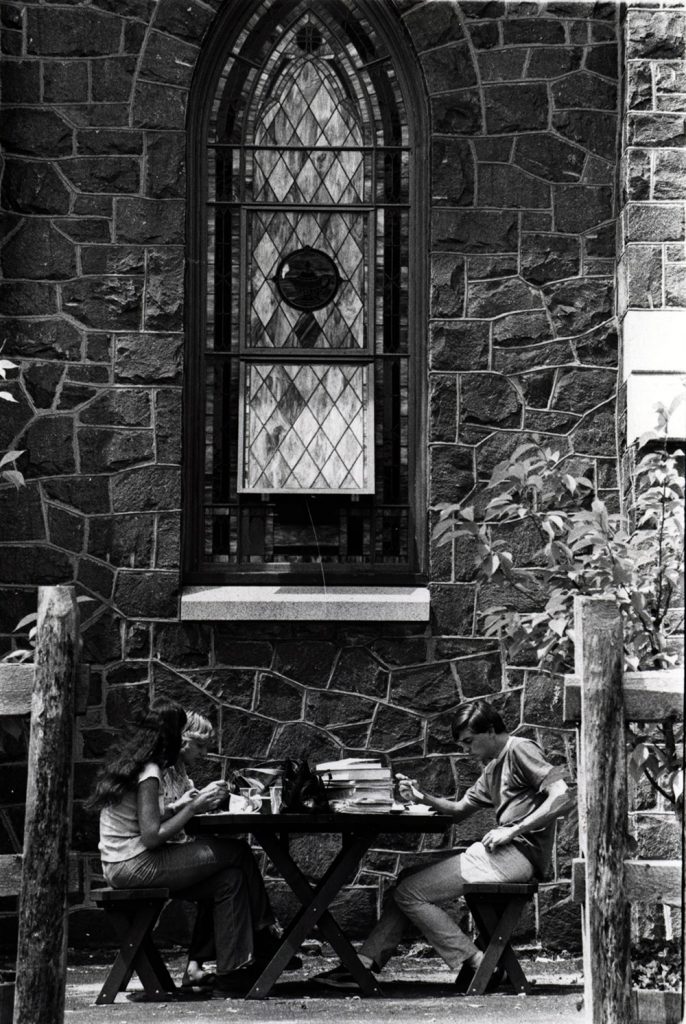
In 1976, university President E.A. Trabant refused to renew the contract for UD Theater Professor Richard Aumiller because Aumiller “placed himself in a position of encouraging, condoning, and sanctioning homosexuality for the undergraduate,” by discussing the university’s gay student group, the Gay Community, in a Philadelphia newspaper (The Philadelphia Inquirer, January 14, 1976). Trabant made the decision to fire Aumiller, who was also the advisor of the student group, after receiving calls from parents of queer students who thanked him for providing a sympathetic environment for gays. Trabant said he feared that UD would become a “mecca for homosexuals.”
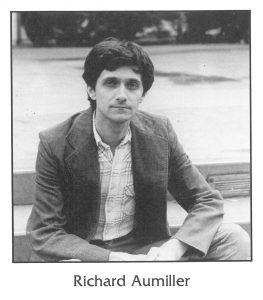
Aumiller sued Trabant and the university for violating his First Amendment right to free speech and his case went to the U.S. District Court of Delaware. While waiting on the court’s decision, Aumiller continued to work—unpaid—to produce the theater department’s fall show as he also contended with unwanted publicity about the lawsuit. During this time, Daugherty Hall was closed to visitors and used as a storage room in the mid-1970s until around 1980 as the university cut operating costs.

In 1977, the court ruled in favor of Aumiller and awarded him back wages and damages. Trabant was forced to personally pay damages for his “pernicious insensitivity” and “wanton disregard” for Aumiller’s rights. Aumiller recalled receiving some support from members of the community, but also that he was verbally harassed and received death threats over the phone. He eventually took a job at Duke University while Trabant continued to serve as president at UD.
In a 1977 article in The Review, UD’s student newspaper, Aumiller said of the decision: “People expect me to be elated (about the court’s decision). But… this has been a very traumatic experience for me. … I grew up with a naive belief in our system of justice,” he continued. “Although justice can be had, it cannot be had quickly or easily.
Meanwhile, the student group that Aumiller advised disbanded after he left UD. Not deterred by the controversy surrounding queer students organizing, Ivo Dominguez Jr. re-organized the Gay Community into the Gay Student Union (GSU) sometime around 1978 and later began hosting weekly Friday evening coffeehouses at Daugherty Hall. Students were initially hesitant to attend these meetings because media coverage of Aumiller’s case revealed deep-seeded homophobia throughout the university and wider Newark communities. Eventually, these informal meetings, which occurred for around five years, gathered twenty or so people together and provided an opportunity for queer people to socialize without the influences of drugs or alcohol.
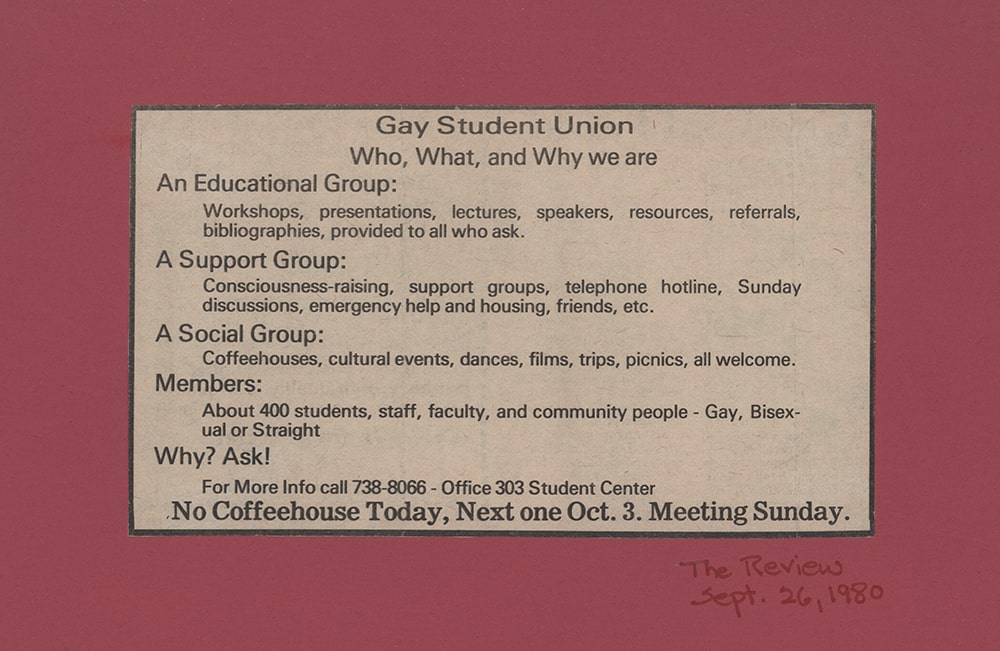
The regular coffeehouses, which welcomed students as well as community members, consisted of discussion groups, game nights, food, and entertainment. Lesbian rap groups, which included information discussion sessions and support groups, met twice monthly during the coffeehouses. Dominguez recalled GSU members volunteering to babysit the children of women while they attended their group sessions. The GSU also brought various speakers to the Newark campus, including queer activists Frank Kameny, Elaine Noble, and Barbara Gittings. Dominguez recalled that if speakers who were queer came to campus, they often ended up stopping by the coffeehouse nights at Daugherty Hall. He even remembered the band the B-52s stopping by after their performance at the Bob Carpenter Center in November 1982.

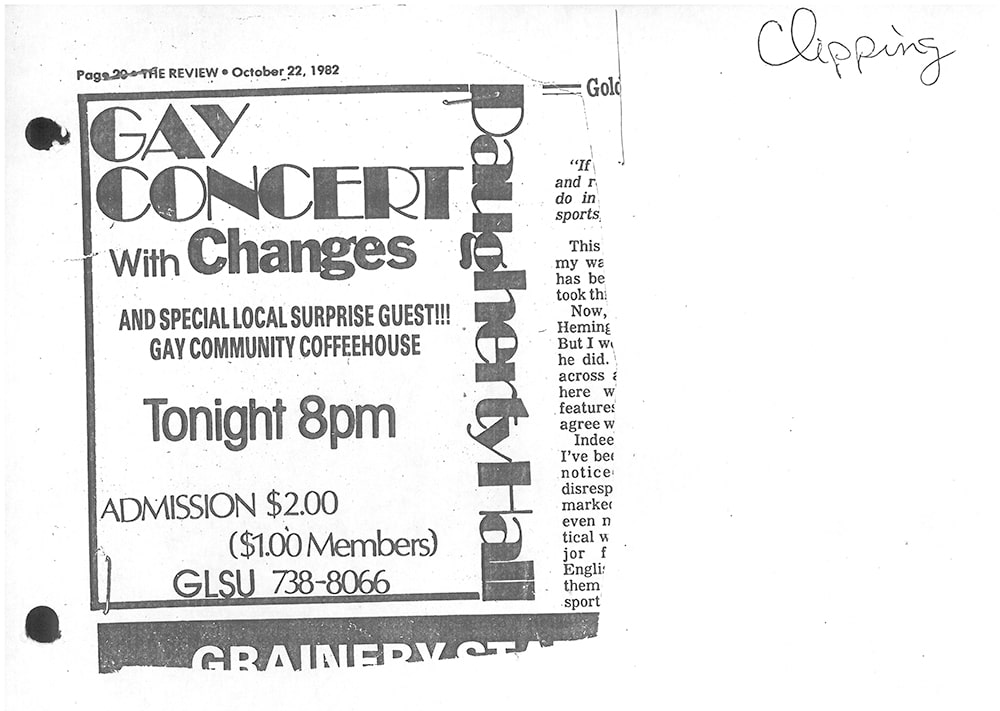
The active queer presence on campus also included “gay awareness events” in the 1980s, in the wake of a false bomb threat to a Daugherty Hall coffeehouse in October 1980. The events aimed to combat the homophobia and harassment occurring in addition to the bomb threat by educating the public about the queer community to allay ongoing fear and hate.
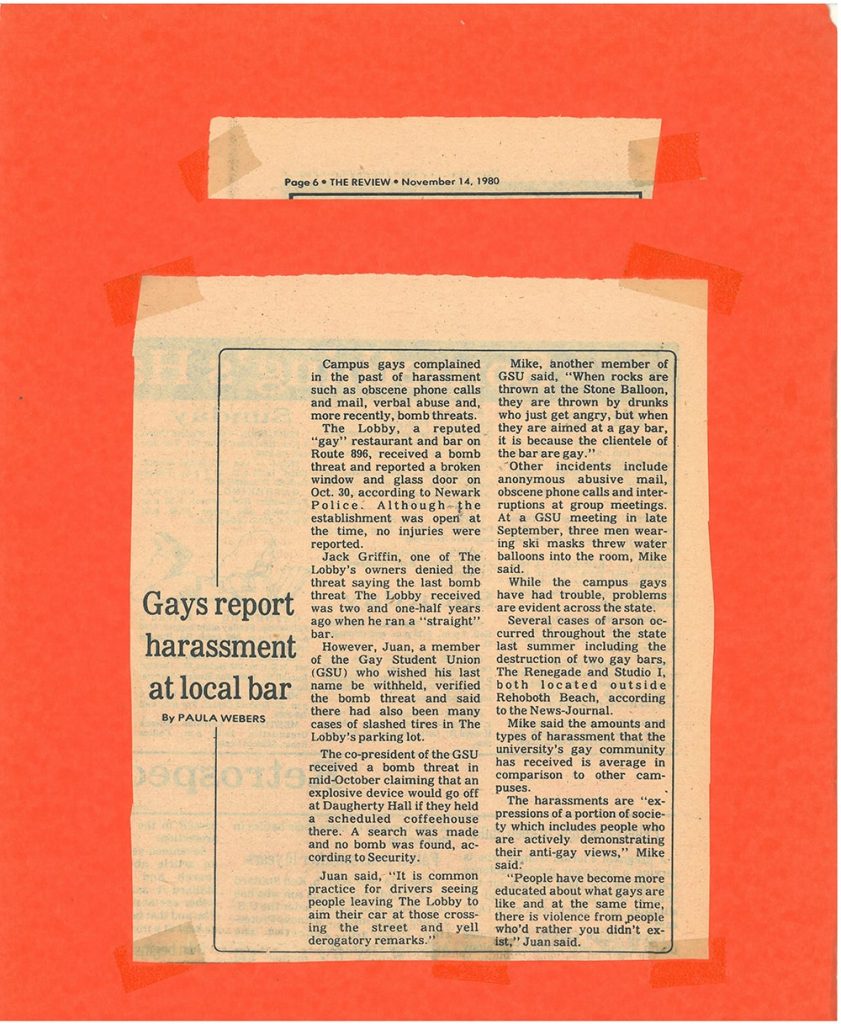
Daugherty Hall was originally built as a Presbyterian church constructed of granite and native brown stone that was dedicated in 1872. Architects Dixon and Davis of Baltimore designed the structure in a Gothic Revival style. The original stained glass windows, which still remain today, were also done in the intricate Gothic Revival style. In 1927, a large, two-story Sunday School wing was added to the rear of the building. The church was sold to the University of Delaware in 1968 and renamed to honor Physics Professor John Denton Daugherty. The building served as UD’s second student center, complete with a student lounge and food court in the basement, until the Trabant Center—named in Trabant’s honor in 1996—was built in the ’90s.
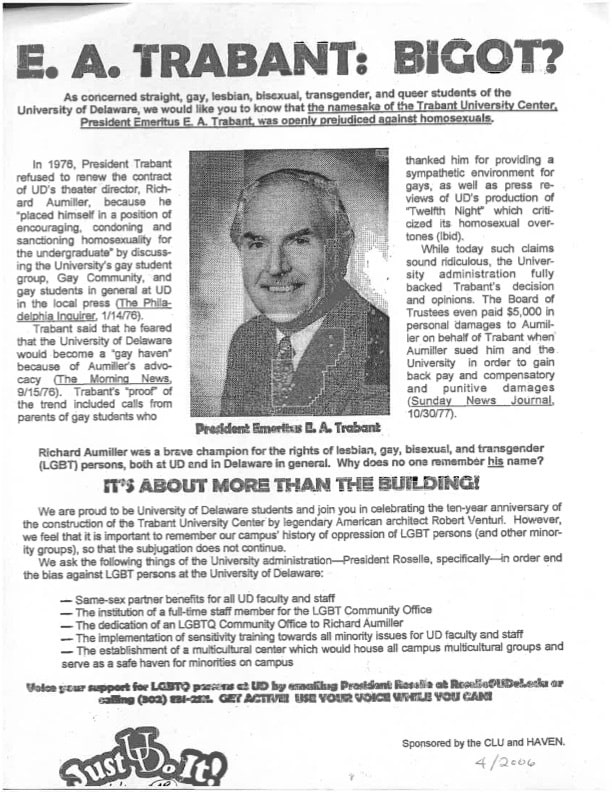
In 1982, Daugherty Hall was listed in the National Register of Historic Places. By 1994, the university demolished the 1927 rear addition to make room for the new Trabant Student Center. Daugherty Hall now stands next to the Trabant Student Center and is used as a quiet study lounge.

Daugherty Hall maintains a queer presence today as the host of the very first annual Lavender Graduation celebration in 2017 and its ongoing utilization by students, gay and straight, every day. The legacy of the GSU lives on through the Lavender Programming Board, which is the current name of the student organization that started as the GSU. The GSU first changed its name to the Gay and Lesbian Student Union and then to the Lesbian, Gay, and Bisexual Student Union in the 1990s, before changing its name to Haven in the early 2000s and then recently changing to the Lavender Programming Board.
Photo Courtesy: University of Delaware Archives and Records Management
Sources:
- About the Lavender Programming Board
- Aumiller v. University of Delaware lawsuit of 1977
- Campus Profile: Daugherty Hall
- Ivo Dominguez Jr. and James Welch oral history interviews with the Division of Historical and Cultural Affairs, 2023
- Lavender Graduation background
- Lynch, T. Gregory, “Court Sides with Aumiller,” The Review, September 9, 1977
- Reife, Mindy, “GSU: Persecution does not deter gay programs after 10 years,” The Review, October 17, 1980
- Villemez, Jason, “The Ongoing Battle Over Employment Discrimination“, Philadelphia Gay News, December 11, 2019
Explore Other Places
-

The Renegade
4274 Coastal Highway, Rehoboth Beach, DE
A once popular gay bar, restaurant, and resort at the Delaware beaches.
-
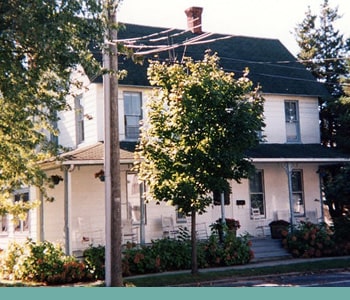
Rehoboth Guest House
40 Maryland Avenue, Rehoboth Beach, DE
A historically queer-friendly guest house that still welcomes visitors today.
-
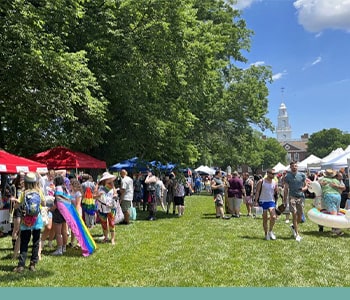
Legislative Hall and Legislative Mall
411 Legislative Avenue, Dover, DE
The site of Delaware’s state capital building and the outdoor location of large, annual LGBTQ+ festivals.
-
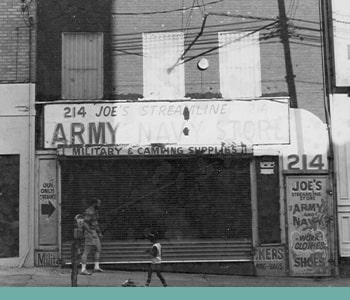
Griffin Community Center
214 N. Market Street, Wilmington, DE
A Former LGBTQ+ community center in northern Delaware that offered a wide variety of services and support during a time of need.
-
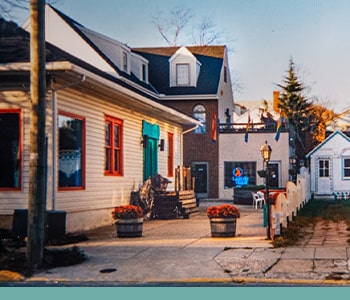
CAMP Rehoboth Community Center
37 Baltimore Avenue, Rehoboth Beach, DE
A longstanding LGBTQ+ community center in Sussex County.


